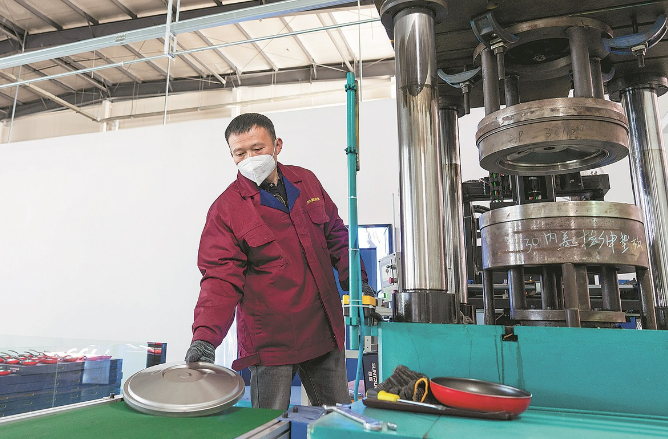Utensils make cooking easier in Xizang
Updated: 2023-12-11 (China Daily)  Print
Print 



An employee works at a cooking utensil factory in Lhasa, Xizang autonomous region, in November last year. ZHOU DIXIAO/XINHUA
LHASA — Before last year, Cai Shuailong had never set foot on the Qinghai-Tibet Plateau, the world's highest plateau, in the Xizang autonomous region. Little did he expect that the stainless steel pressure cooker manufacturing company, where he serves as general manager, would one day open a factory there to produce high-altitude cooking utensils.
Now, the 42-year-old embarks on a 4,000-kilometer journey across the heartland of China every month, shuttling between his company's headquarters in East China's Zhejiang province and Lhasa, capital of Xizang, in Southwest China.
The company's Lhasa factory started production in November last year. So far, it has sold 600,000 high-altitude utensils in Xizang. More than half the items are pressure cookers that use a new patented technology to better meet the real-life needs of people living on the plateau.
In high-altitude regions, the high elevation, low air pressure and low boiling point of water make conventional cooking a time-consuming and laborious process. For example, in Nagchu, a prefecture-level city in northern Xizang with an average altitude of over 4,500 meters, water boils at around 85 C, according to a local restaurant server.
Pressure cookers address this problem, as they increase internal pressure through continuous heating, which raises the boiling point of water and speeds up the cooking process.
The first pressure cooker was invented in the 17th century by French physicist Denis Papin and they gained popularity in the late 19th and early 20th centuries. China's first domestic pressure cooker was produced in the northeastern city of Shenyang, Liaoning province, in 1964.
On the plains, a pressure cooker may just be an option for those looking to improve their cooking. But in Xizang, where the average altitude exceeds 4,000 meters, a functional pressure cooker has become a necessity for almost every household to cook yak meat and mutton as well as dumplings and noodles.
Traditional pressure cookers on the Chinese market have a single pressure release mechanism, and it is not easy to control the timing and heat when cooking noodles. A slight error can easily lead to the noodles "squirting" out. This occurrence was brought to light in a short video filmed in Lhasa and circulated online. The video captured a man cooking noodles in a pressure cooker, resulting in them splattering all over him.
To solve the problem, Cai's company designed a new pressure cooker utilizing patented "one-button quick release" technology. "It can vent quickly in about a minute, and water will not spray out from the release valve," Cai said.
This pressure cooker also boasts a temperature reminder function, resolving the difficulty of controlling the cooking time and heat while cooking dumplings or noodles.
"When the temperature inside the pot reaches 100 C, it will automatically sound an alarm. If cooking freshly wrapped dumplings, they will be cooked in 15 seconds after the alarm. For frozen dumplings, they will be cooked in two minutes after the alarm," he explained.
In Konglang village in Namling county, Shigatse, 50-year-old Dorje Yarphel said he is very content with his new pressure cooker.
"It heats up quickly and cooks yak meat thoroughly in no time. It's significantly safer and more convenient than the pots we used to have," he said.
The hospitable Dorje Yarphel and his wife, Sonam, offered Xinhua reporters a taste of a big piece of yak meat cooked in their new pressure cooker.
Given the low population density and relatively small market in high-altitude regions, cookware manufacturers generally don't actively target such areas for product development. The transition from the old-fashioned, single-function pressure cooker to the new one incorporating multiple patented technologies — the "metamorphosis" of pressure cookers on the snowy plateau — is mainly due to the strong commitment of local authorities to tackle problems encountered in the daily lives of the people.
While visiting residents, regional officials learned about the many inconveniences faced in using traditional pressure cookers at high altitudes.
As a result, they instructed related departments to expedite the development of high-altitude multifunctional cookware. The initiative gained potent support from industry associations and major enterprises such as Suntrue, leading to a significant transformation in cooking utensils, including pressure cookers, in the region.
In addition to pressure cookers, the high-altitude cooking utensil project encompasses the development and production of kettles capable of boiling water to 100 C, as well as high-altitude steamers that can reach temperatures of up to 135 C.
A highly anticipated "fully automatic buttered tea maker" is also set to hit the market soon.
Wu Qing, deputy director of the China Daily Hardware Technology Development Center, said that nearly 60 years after the debut of the first domestic pressure cooker, the development of new pressure cookers and other cookware specifically designed for use in high-altitude regions is a milestone for China's cookware industry.
The new type of pressure cooker features an engraved logo of the trademark Xue Lian Hua, the rare snow lotus that grows at high altitudes.
Cai said: "This logo looks like the character for 'fire' and also resembles the character for 'prosperity' in Chinese, symbolizing that the people's lives will become increasingly prosperous and thrive."
Xinhua








